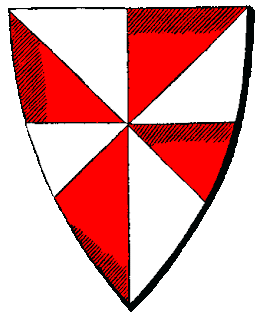I never knew where the terms came from but perhaps they are linked to
heraldic ones. A ‘fess’ or ‘fesse’ is a single horizontal bar that runs across
the middle of a shield and ‘gyrons’ or ‘girons’ are the triangles that can
radiate from the centre of a shield. Interestingly in English
armoury one of the lines forming the pattern must be in fesse. Therefore a gyron
must emanate from a point on the fess.
The reason I have returned to this topic is because I’ve had an e mail
(text in italics below) from Adam Stone asking me to clarify some points.
I'm fascinated with
your discussion on giron's and fess points. I'm familiar with the Coldstream/
Uglow approach but this other approach sounds to be as you suggest more
reflective of our perceptual embodied experience. I'm keen to know how you
determined the fess points as the students obviously all have different
perspectives of the subject. I'm also interested to know if the exploratory
giron's are purely lines that register relationships or are they able to
describe forms. I hope these don't seem stupid questions I'm interested in
introducing these concepts in some drawing classes and just want to get a
handle on it. Perhaps as you also point out its often better that these issues
are only partially understood even by the tutor. As we're dealing with
perception I guess that is understandable.
He picks up some interesting issues. The fess points were sometimes
physically determined, but they were meant to work as points held in the mind.
For example, we might construct a series of string lines through a space, by masking taping the ends of string lengths to selective points on the edge of objects
that were to be drawn. In order to get students to focus on an important position
in the space that had now been activated by the string we might clip a peg on
the string line that represented where a fess point might well be. From that
point we could clip another string end and take its other end to another
significant point. We would then take out the string construction. Students had
to imagine the point in space where the peg was. (They had probably already
done some measured drawing so were getting used to making decisions as to where
something might be). We would then start to construct another simple set of
relationships, perhaps the bottom of a easel’s leg to the edge of a box,
pointing out as this was done that the significant moment in space has shifted
as our attention had moved to another set of relationships. However what had
not changed was the overall position of what we were drawing, the box and easel
were still in the same place, but our scanning and attention within and around
the dynamics of the space was altering as our eyes and head moved in order to
explore the situation. Patrick Oliver used to use the analogy of a bird flying
through a thick-set hedge. It was able to do this because it flew through the
space rather than trying to avoid the mass of tiny branches and thorns. These
fess points were therefore points on the eye’s flight path through the space.
OK it might not be an exact science, but that was also the point, you had to
imaginatively inhabit the space.
The girons would search out important points as they radiated out from
the fess points through the space and as Adam has suggested they could at times
feel their way across a surface and help to define its shape and mass as well
as its spatial presence. A curve was usually described as a series of
constantly moving tangents; this enabled a curve to be thought of as a series
of straight lines forming the edges of an infinite sided polygon. Each
imaginary line was therefore capable of seeking out a connection with another
spatial point. In simple plan view it would be like this. (below)
Students would however
construct curves over and around solids that moved back and forwards (imagine a slightly
curved perspective plane) to help understand how the mass moved into the space. More like this. (Below)
Above all this is an imaginary curved space rather than a flat measured one. There
is no right answer, but there is an implication that students must try and
inhabit the space in their minds and as they do so move through that space and
make sense of it in the same way that we do in everyday situations such as
walking through a crowded room We seem to manage to get through from one side
to the other of a room without constantly bumping into things, therefore we
must be walking through the space, an ability that is never about a static set
of measurements but about an active series of readjustments.
At some point when I have more time I will make a drawing based on the issues we used to set out and photograph each stage. As always there is a huge distance between the written description of an act and a visual record.



No comments:
Post a Comment